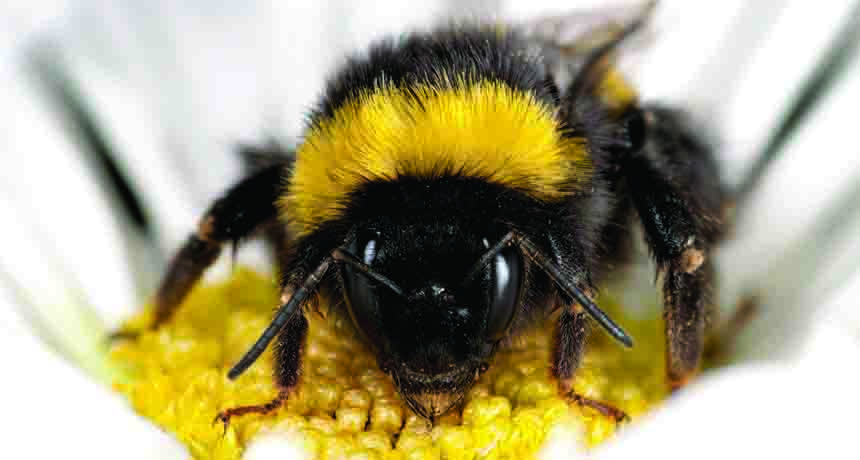Passing diseases from bee to bee
Infections can spread from honeybees to wild bumblebees

This wild bumblebee came to a flower in search of food. It will pick up some pollen in the process — and maybe a disease too. That's the worry of scientists studying the transfer of pathogens to wild bees.
Matthias A. Fürst
It’s not easy being a bee, no matter where you buzz. A variety of diseases threaten these ace pollinators of farm crops. And they are one reason that up to one-third of the honeybee colonies kept by U.S. beekeepers have been dying off each year. Now, a large new survey of buzzing pollinators in and around Great Britain delivers yet more grim news. The same viruses and parasites that sicken honeybees can spill over and infect wild bumblebees.
The new finding could help explain why populations of bumblebees also are shrinking. And that could be a big deal because these busy little buzzers also excel at pollination.
As they flit from flower to flower, a bee transfers a plant’s male reproductive cells — pollen — to the female parts of these blooms. This process, called pollination, fertilizes plants. And that fertilization makes it possible for plants to produce fruits, vegetables, nuts and berries. The new concern is that a honeybee might also leave behind traces of any virus or other disease-causing agent it picked up outdoors or in its hive. And as beekeepers move honeybees around from farm to farm, helping pollinate fields, they risk moving any of their bees’ pathogens to new regions as well. (Pathogens are organisms that cause disease.)
A lot is at stake
Honeybees receive a lot of the attention for their role in pollination. Indeed, they are the leading pollinator of U.S. food crops. The U.S. Department of Agriculture values their role in crop production at about $15 billion. Without their services, many foods would be more scarce, more expensive or both. And that is why scientists are racing to find out more about bee diseases.
Mark Brown led the new study. A biologist, he works at Royal Holloway, University of London, in Egham, England. Previous small studies had suggested that diseases can spread from commercial hives to wild bees. Brown and his coworkers have been exploring pathogens that infect bees.
In laboratory experiments, they studied deformed wing virus, which infects the common honeybee (Apis mellifera). Wild bumblebees (Bombus terrestris) can pick up this pathogen, the researchers showed. And on average, infected bumblebees died six days sooner than bumblebees without the virus. Those six days are important. They represent between one-quarter and one-third of the bumblebee’s adult life. The scientists also found that a honeybee parasite called Nosema ceranae can infect bumblebees. It also can sicken them.
The researchers also studied bees caught at 26 outdoor locations in Great Britain and the Isle of Man. Both deformed-wing virus and the Nosema parasite infect these bees, these surveys showed. For example, the virus appeared in more than one out of every three honeybees caught outdoors. It also occurred in about one in every 10 wild bumblebees.
Brown’s team describes its new findings in the February 20 issue of Nature.
For decades, bee-parasite research has focused on honeybees, Peter Graystock told Science News. A biologist at the University of Sussex in Brighton, England, he did not work on the new study. Graystock said that studies, including this new one, show parasites and other pathogens don’t infect just honeybees. And that could be a big problem. Wild pollinators fertilize some farm crops — as well as wild plants. If something happens to these wild bees, the consequences could be far-reaching, he worries.
Power Words
biology The study of living things. The scientists who study them are known as biologists.
parasite A creature that gets a benefit from another organism, called a host, but doesn’t provide it any benefits. Classic examples of parasites include ticks, fleas and tapeworms.
pathogen An organism that causes disease.
pollen Powdery grains released by the male parts of flowers that can fertilize the female tissue in other flowers.
pollinate To transport male reproductive cells — pollen — to female parts of a flower. This allows fertilization, the first step in plant reproduction.
virus Tiny infectious agents consisting of RNA or DNA surrounded by protein. Viruses can reproduce only by injecting their genetic material into the cells of living creatures. Although scientists frequently refer to viruses as live or dead, in fact no virus is truly alive. It doesn’t eat like animals do, or make its own food the way plants do. It must hijack the cellular machinery of a living cell in order to survive.







